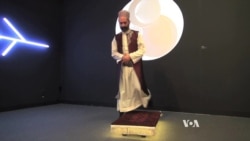A performance piece by Darvish Fakhr was hard to miss on the first day of the Armory Art Show, New York’s oldest and largest contemporary art fair. Wearing a mash-up of traditional Middle Eastern dress - a fez from Oman, caftan from Iran and robe from a shop in London - Fakhr tooled about on a motorized, illuminated skateboard covered with what looked like a prayer rug. He called it “Whirring Darvish,” and said it was about sending up stereotypes of the Middle East.
“It’s a play on that exaggeration of people’s tendency to stereotype, and it’s something I have been subject to growing up in the States. As a half-Iranian growing up during the Iranian revolution, I was suddenly the scapegoat for a lot of hatred and anger I didn’t understand,” Fakhr said, adding that it was his first performance piece.
The London-based Fakhr, a painter, was among the artists from the Middle East, North Africa and the Mediterranean whose work was the regional focus at this year’s Armory show, installed in 15 of the fair’s nearly 200 mini-galleries.
“My piece is about bringing a quality to the show that had a sense of lightness to it, a sense of lightness in my being, and also a sense of lightness in the humor aspect,” Fakhr said. “It’s a way of me being able to dismantle some of my cultural identity, and reassemble it in a collage that made sense to me.”
A solo work by Iraqi American artist Wafaa Bilal was also tongue-in-cheek, but with a more serious intent. His large golden bust of former dictator Saddam Hussein, wearing a hat modeled like Jerusalem’s Dome of the Rock, was installed next to a rendering showing the bust in outer space, orbiting the Earth. He said the bust was an exact replica of an actual statue.
“The work was inspired by an idea of the Ba’ath regime in the 1980's and 90's, to construct a bust of Saddam Hussein in gold, and then send it into space,” Bilal said. “And I am revisiting this idea right now in a way to highlight the condition in how people reach such a point to elevate a dictator to the status of God.”
Bilal said the work, named “Canto III,” is not finished. The second stage, he said, is literally launching the bust into space, via a Russian rocket.
“And then geo-synchronize [it] on top of Iraq exactly, and it will be a shining star, just a reminder of one time we went through a hard time, and we have to remember that it’s the past, and look into the future as well,” he said.
In the meantime, Bilal is also making Saddam-bust bookends and candleholders, a project that he has advertised for U.S. veterans to participate in for $6 an hour - to highlight what he considers their exploitation and neglect. So far, he said only a few have signed on.
He said the project was also serving him as a kind of “therapeutic act.”
“The idea of turning a dictator into decorative art is to dismantle the fear we carry with us through our lives of that dictator,” he said. “I worked with this figure so long, to the point [that] it lost its meaning.”






